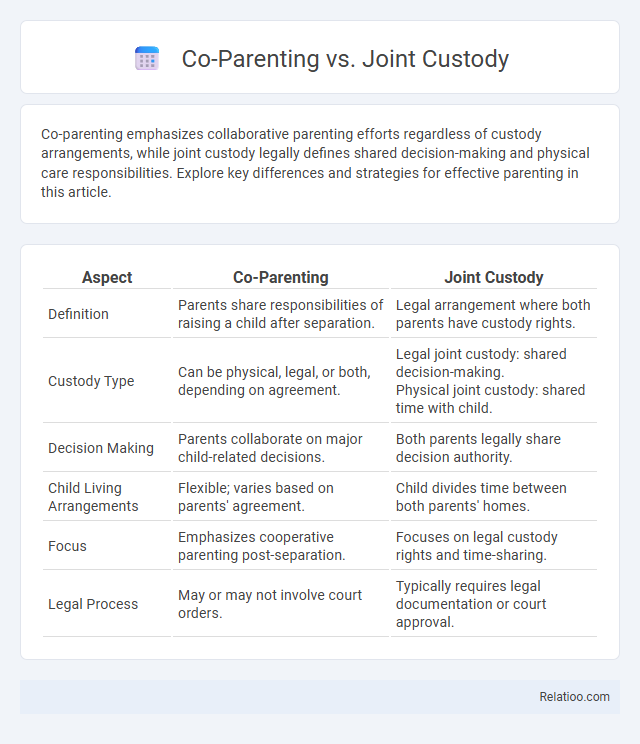Co-parenting emphasizes collaborative parenting efforts regardless of custody arrangements, while joint custody legally defines shared decision-making and physical care responsibilities. Explore key differences and strategies for effective parenting in this article.
Table of Comparison
| Aspect | Co-Parenting | Joint Custody |
|---|---|---|
| Definition | Parents share responsibilities of raising a child after separation. | Legal arrangement where both parents have custody rights. |
| Custody Type | Can be physical, legal, or both, depending on agreement. | Legal joint custody: shared decision-making. Physical joint custody: shared time with child. |
| Decision Making | Parents collaborate on major child-related decisions. | Both parents legally share decision authority. |
| Child Living Arrangements | Flexible; varies based on parents' agreement. | Child divides time between both parents' homes. |
| Focus | Emphasizes cooperative parenting post-separation. | Focuses on legal custody rights and time-sharing. |
| Legal Process | May or may not involve court orders. | Typically requires legal documentation or court approval. |
Understanding Co-Parenting and Joint Custody
Understanding co-parenting and joint custody is essential for effective child-rearing after separation. Co-parenting refers to the collaborative effort between parents to raise their child, emphasizing communication and shared responsibilities, while joint custody legally divides physical and legal rights between both parents. Your ability to navigate these arrangements directly impacts your child's well-being and stability.
Key Differences Between Co-Parenting and Joint Custody
Co-parenting refers to the ongoing cooperative relationship between parents in raising their child, emphasizing communication and shared responsibilities, while joint custody is a legal arrangement granting both parents formal rights and responsibilities over the child's upbringing. The key difference lies in that joint custody legally defines the decision-making authority and physical care, whereas co-parenting focuses on the quality of collaboration without necessarily involving legal parameters. Your understanding of these distinctions helps navigate parenting plans that best support your child's well-being and stability.
Legal Definitions and Implications
Co-parenting refers to the collaborative approach parents take to raise their child, emphasizing communication and shared responsibilities without specific legal mandates. Joint custody, a legal term, grants both parents the right to make significant decisions about the child's welfare, schooling, and medical care, often divided into physical and legal custody categories. Understanding these distinctions helps you navigate family law to ensure your parental rights and responsibilities are clearly defined and protected.
Benefits of Co-Parenting Arrangements
Co-parenting arrangements promote active involvement from both parents, fostering emotional stability and consistent support for the child. Unlike joint custody, which primarily addresses legal and physical time-sharing, co-parenting emphasizes collaborative decision-making and communication to meet the child's needs effectively. Benefits include reduced parental conflict, enhanced child well-being, and the development of a more resilient family dynamic focused on cooperation.
Pros and Cons of Joint Custody
Joint custody allows both parents to share legal and physical responsibilities, providing Your child with consistent involvement from both sides, which can enhance emotional stability and decision-making. However, challenges arise when parents have conflicting schedules or communication issues, potentially causing confusion and tension for the child. While co-parenting emphasizes cooperation and shared parenting duties, joint custody legally formalizes these roles but may require more structured agreements to avoid disputes.
Communication Strategies for Successful Co-Parenting
Effective communication strategies for successful co-parenting involve clear, consistent, and respectful dialogue between parents to ensure the child's needs are prioritized. Joint custody arrangements benefit from structured communication tools such as shared calendars, regular meetings, and agreed-upon protocols to minimize conflicts and enhance cooperation. Prioritizing open discussion, active listening, and conflict resolution techniques helps maintain a stable environment essential for the child's emotional well-being across co-parenting frameworks.
How to Establish Effective Joint Custody Agreements
Establishing effective joint custody agreements requires clear communication between parents, outlining detailed schedules for decision-making and physical custody to minimize conflicts. Your agreement should include provisions for resolving disputes, ensuring both parents have equal input in major aspects like education, healthcare, and extracurricular activities. Utilizing mediation or legal counsel can help create a balanced plan that prioritizes the child's well-being while supporting cooperative co-parenting.
Impact on Children: Co-Parenting vs. Joint Custody
Co-parenting fosters a collaborative environment where both parents actively participate in decision-making and daily child-rearing, promoting emotional stability and consistent routines for children. Joint custody legally grants both parents equal rights and responsibilities, which can enhance a child's sense of security by maintaining strong relationships with both parents. The impact on children is generally more positive when co-parenting emphasizes cooperation and communication, reducing conflict and supporting healthy development.
Navigating Challenges and Conflict Resolution
Navigating challenges in co-parenting requires clear communication and mutual respect to prioritize Your child's well-being while minimizing conflicts. Joint custody involves shared decision-making responsibilities, where effective conflict resolution strategies like mediation or counseling can help address disputes and maintain a stable environment. Successful co-parenting balances cooperation and flexibility, ensuring that parental roles are defined while adapting to changing circumstances for Your child's best interests.
Choosing the Right Custody Arrangement for Your Family
Choosing the right custody arrangement for your family involves understanding the distinctions between co-parenting, joint custody, and sole custody. Co-parenting emphasizes collaborative parenting efforts regardless of the legal custody status, while joint custody legally assigns shared decision-making and physical custody responsibilities between parents. Evaluating your family dynamics, communication skills, and the best interests of your child are essential factors in determining a custody setup that promotes stability and healthy development.

Infographic: Co-parenting vs Joint Custody
 relatioo.com
relatioo.com